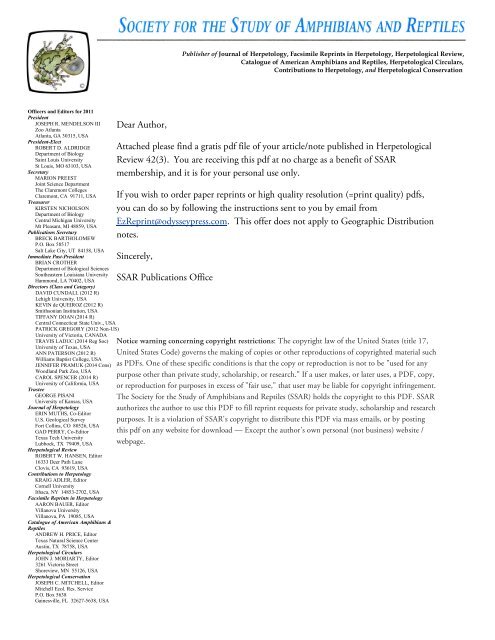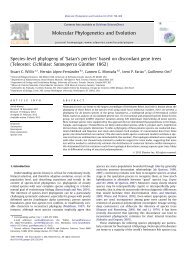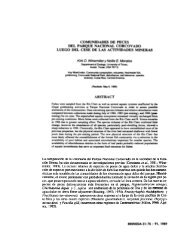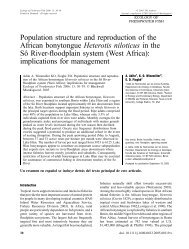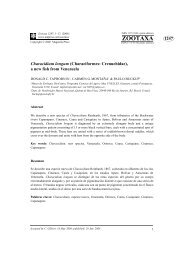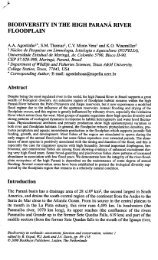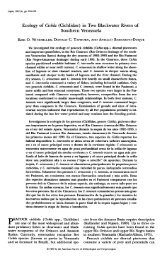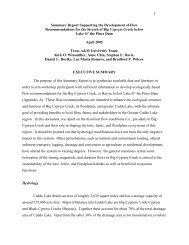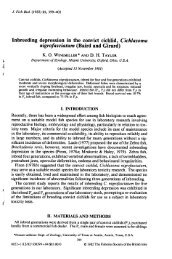CERATOPHRYS CRANWELLI (Cranwell's Horned Frog): Diet
CERATOPHRYS CRANWELLI (Cranwell's Horned Frog): Diet
CERATOPHRYS CRANWELLI (Cranwell's Horned Frog): Diet
Create successful ePaper yourself
Turn your PDF publications into a flip-book with our unique Google optimized e-Paper software.
Publisher of Journal of Herpetology, Facsimile Reprints in Herpetology, Herpetological Review,<br />
Catalogue of American Amphibians and Reptiles, Herpetological Circulars,<br />
Contributions to Herpetology, and Herpetological Conservation<br />
Officers and Editors for 2011<br />
President<br />
JOSEPH R. MENDELSON III<br />
Zoo Atlanta<br />
Atlanta, GA 30315, USA<br />
President-Elect<br />
ROBERT D. ALDRIDGE<br />
Department of Biology<br />
Saint Louis University<br />
St Louis, MO 63103, USA<br />
Secretary<br />
MARION PREEST<br />
Joint Science Department<br />
The Claremont Colleges<br />
Claremont, CA 91711, USA<br />
Treasurer<br />
KIRSTEN NICHOLSON<br />
Department of Biology<br />
Central Michigan University<br />
Mt Pleasant, MI 48859, USA<br />
Publications Secretary<br />
BRECK BARTHOLOMEW<br />
P.O. Box 58517<br />
Salt Lake City, UT 84158, USA<br />
Immediate Past-President<br />
BRIAN CROTHER<br />
Department of Biological Sciences<br />
Southeastern Louisiana University<br />
Hammond, LA 70402, USA<br />
Directors (Class and Category)<br />
DAVID CUNDALL (2012 R)<br />
Lehigh University, USA<br />
KEVIN de QUEIROZ (2012 R)<br />
Smithsonian Institution, USA<br />
TIFFANY DOAN (2014 R)<br />
Central Connecticut State Univ., USA<br />
PATRICK GREGORY (2012 Non-US)<br />
University of Victoria, CANADA<br />
TRAVIS LADUC (2014 Reg Soc)<br />
University of Texas, USA<br />
ANN PATERSON (2012 R)<br />
Williams Baptist College, USA<br />
JENNIFER PRAMUK (2014 Cons)<br />
Woodland Park Zoo, USA<br />
CAROL SPENCER (2014 R)<br />
University of California, USA<br />
Trustee<br />
GEORGE PISANI<br />
University of Kansas, USA<br />
Journal of Herpetology<br />
ERIN MUTHS, Co-Editor<br />
U.S. Geological Survey<br />
Fort Collins, CO 80526, USA<br />
GAD PERRY, Co-Editor<br />
Texas Tech University<br />
Lubbock, TX 79409, USA<br />
Herpetological Review<br />
ROBERT W. HANSEN, Editor<br />
16333 Deer Path Lane<br />
Clovis, CA 93619, USA<br />
Contributions to Herpetology<br />
KRAIG ADLER, Editor<br />
Cornell University<br />
Ithaca, NY 14853-2702, USA<br />
Facsimile Reprints in Herpetology<br />
AARON BAUER, Editor<br />
Villanova University<br />
Villanova, PA 19085, USA<br />
Catalogue of American Amphibians &<br />
Reptiles<br />
ANDREW H. PRICE, Editor<br />
Texas Natural Science Center<br />
Austin, TX 78758, USA<br />
Herpetological Circulars<br />
JOHN J. MORIARTY, Editor<br />
3261 Victoria Street<br />
Shoreview, MN 55126, USA<br />
Herpetological Conservation<br />
JOSEPH C. MITCHELL, Editor<br />
Mitchell Ecol. Res. Service<br />
P.O. Box 5638<br />
Gainesville, FL 32627-5638, USA<br />
Dear Author,<br />
Attached please find a gratis pdf file of your article/note published in Herpetological<br />
Review 42(3). You are receiving this pdf at no charge as a benefit of SSAR<br />
membership, and it is for your personal use only.<br />
If you wish to order paper reprints or high quality resolution (=print quality) pdfs,<br />
you can do so by following the instructions sent to you by email from<br />
EzReprint@odysseypress.com. This offer does not apply to Geographic Distribution<br />
notes.<br />
Sincerely,<br />
SSAR Publications Office<br />
Notice warning concerning copyright restrictions: The copyright law of the United States (title 17,<br />
United States Code) governs the making of copies or other reproductions of copyrighted material such<br />
as PDFs. One of these specific conditions is that the copy or reproduction is not to be "used for any<br />
purpose other than private study, scholarship, or research." If a user makes, or later uses, a PDF, copy,<br />
or reproduction for purposes in excess of "fair use," that user may be liable for copyright infringement.<br />
The Society for the Study of Amphibians and Reptiles (SSAR) holds the copyright to this PDF. SSAR<br />
authorizes the author to use this PDF to fill reprint requests for private study, scholarship and research<br />
purposes. It is a violation of SSAR's copyright to distribute this PDF via mass emails, or by posting<br />
this pdf on any website for download — Except the author's own personal (not business) website /<br />
webpage.
Natural History Notes 409<br />
California, USA, I encountered an adult Western Toad in pectoral<br />
amplexus with an adult female California Red-legged <strong>Frog</strong>. Both<br />
the toad and frog were on the terrestrial bank of a livestock pond<br />
(Fig. 1). The toad was clasped tightly to the frog’s thoracic region,<br />
while the California Red-legged <strong>Frog</strong> appeared completely immobilized<br />
by the toad.<br />
Davian behavior has been considered an ecological trap<br />
because, in this case, the toad was not capable of successfully<br />
reproducing (Ayres 2010, op. cit.). In this observation, however,<br />
neither animal was able to reproduce successfully since both<br />
were on land, and reproductively viable conspecifics were in<br />
aquatic breeding habitat and not accessible to either individual.<br />
Predation events may increase during reproductive activity in<br />
many species (Magnhagen 2003. Trends Ecol. Evol. 6:183–186).<br />
Here, both individuals were exposed to an increased predation<br />
potential due to their distance from water (ca. 1 m). The California<br />
Red-legged <strong>Frog</strong> may have also been subjected to an unanticipated<br />
physical stress that was brought on by the Western<br />
Toad’s grasp (Fig. 2).<br />
On other occasions, I have observed Western Toad males<br />
amplexing a root ball of Juncus balticus, a piece of cattle dung,<br />
and a dead conspecific individual. Arak (In Bateson 1983. Mate<br />
Choice. Cambridge Univ. Press. New York, New York. 462 pp.)<br />
suggested explosive breeding is the reason for necrogamy (Davian<br />
behavior). Among the objects reported by Arak (1983, op.<br />
cit.) were fish and floating debris. I integrate the hypothesis that<br />
temporally compressed breeding anurans comprise males that<br />
will attempt to amplex appropriately sized nearby objects as a<br />
result of breeding pressure from conspecifics. Although Ayres<br />
(2010, op. cit.) proposed that chemical factors might influence<br />
necrogamy in B. bufo, I offer that objects of the appropriate size<br />
are targets for Davian behavior, and that there is little regard for<br />
their composition. I further add that a heterospecific individual<br />
attempting to escape amplexus attempts would facilitate complete<br />
amplexal behavior by the Western Toad. Although Davian<br />
behavior may represent an evolutionary trap for individual<br />
Western Toads, it also represents confounding stresses on a<br />
threatened species, in this case, the California Red-legged <strong>Frog</strong>.<br />
This observation represents reduced opportunities for reproduction<br />
and increased predation risk in both species. Western<br />
Toads appear to engage in this behavior at an observable rate,<br />
which was observed by me over several years. If the target is<br />
a sympatric species, local populations of both the California<br />
Red-legged <strong>Frog</strong> and the Western Toad might be effected.<br />
I thank Sarah M. Foster for her comments and assistance on<br />
the manuscript.<br />
JEFF A. ALVAREZ, The Wildlife Project, P.O. Box 579805, Modesto, California<br />
95357, USA; e-mail: Jeff@thewildlifeproject.com.<br />
Fig. 1. Bufo terrestris consuming a Marsh Crab (Sesarma cinereum),<br />
Charleston Co., South Carolina, USA.<br />
HOLLY N. JONES, Riverbanks Zoo and Garden, P.O. Box 1060, Columbia,<br />
South Carolina. USA; (e-mail: hjones24@gmail.com.<br />
<strong>CERATOPHRYS</strong> <strong>CRANWELLI</strong> (Cranwell’s <strong>Horned</strong> <strong>Frog</strong>). DIET.<br />
Data on the diet of the anurophagous frogs of the Gran Chaco in<br />
South America is sparse (Scott and Aquino 2005. In Donnelly et<br />
al. [eds.], Ecology and Evolution in the Tropics: A Herpetological<br />
Perspective, pp. 243–259. Univ. Chicago Press, Chicago, Illinois).<br />
One species, Ceratophrys cranwelli, is frequently encountered in<br />
the Gran Chaco, but only three anurans have been confirmed as<br />
comprising part of its diet; Leptodactylus bufonius (Schalk 2010.<br />
Herpetol. Rev. 41:471), Physalaemus biligonigerus, and an unidentified<br />
Leptodactylus sp. (Scott and Aquino 2005, op. cit.).<br />
On 31 Dec 2010 at 2230 h we came upon a pair of C. cranwelli<br />
in amplexus in a temporary pond (19.60434°S, 62.57558°W;<br />
WGS 84) in the Isoceño community of Yapiroa, Province Cordillera,<br />
Department of Santa Cruz, Bolivia. While being grasped by<br />
the male C. cranwelli, the female was observed eating an adult<br />
Physalaemus albonotatus (Fig. 1). The P. albonotatus made continuous<br />
attempts to free itself from the mouth of the female, but<br />
it was consumed after approximately ten minutes. The pair remained<br />
on the edge of the pond for two minutes, after which the<br />
female (with the male still grasping her) then lunged at a male<br />
BUFO TERRESTRIS (Southern Toad). DIET. Bufo terrestris has<br />
been reported to prey on a variety of invertebrate species including<br />
snails, ants, beetles, crickets, and bees (Dorcas and Gibbons<br />
2008. <strong>Frog</strong>s and Toads of the Southeast. Univ. Georgia Press,<br />
Athens, Georgia. 238 pp.; Jensen et al. [eds.] 2008. Amphibians<br />
and Reptiles of Georgia. Univ. Georgia Press, Athens, Georgia.<br />
600 pp.). On 12 July 2007 on Edisto Island, South Carolina, USA,<br />
a large adult female Bufo terrestris was observed consuming a<br />
Marsh Crab (Sesarma cinereum). The observation took place in<br />
an area where S. cinereum are common. This may suggest that<br />
S. cinereum is available as a significant food source for coastal<br />
populations of Bufo terrestris.<br />
Fig. 1. A female Ceratophrys cranwelli consuming a Physalaemus albonotatus<br />
while being amplexed by a male C. cranwelli. Located in<br />
the lower right of the photo is the male Rhinella major that the female<br />
C. cranwelli attempted to capture after ingesting the Physalaemus.<br />
Herpetological Review 42(3), 2011
410 Natural History Notes<br />
Rhinella major that was calling approximately 10 cm away (visible<br />
in Fig. 1). The female C. cranwelli failed to capture the R.<br />
major, which escaped into a nearby cluster of plants. The pair<br />
then swam into the middle of the pond, presumably to mate.<br />
This observation confirms one additional anuran species and<br />
supports the possibility of another anuran species in the diet of<br />
C. cranwelli.<br />
Funding was provided by the National Science Foundation’s<br />
Graduate Research Fellowship Program (awarded to CMS).<br />
CHRISTOPHER M. SCHALK (e-mail: cschalk@tamu.edu) and CARMEN<br />
G. MONTAÑA, Department of Wildlife and Fisheries Sciences, Texas A&M<br />
University, College Station, Texas 77843-2258, USA.<br />
CHAPERINA FUSCA (Saffron-bellied <strong>Frog</strong>). OCULAR ANOMALY.<br />
Chaperina fusca is a small anuran (to 26 mm SVL) with an ovalshaped<br />
body, small head, blunt and projecting snout, fine dermal<br />
spine on each elbow and heel, greenish or bluish black dorsum<br />
with whitish or bluish dots, brown limbs with dark bars, and the<br />
highly distinctive ventral coloration of numerous yellow to rich<br />
yellow blotches bordered by a dark brown network (Inger 2005.<br />
The Systematics and Zoogeography of the Amphibia of Borneo.<br />
Natural History Publications [Borneo] Sdn. Bhd. Kota Kinabalu.<br />
402 pp.; Inger and Stuebing 2005. A Field Guide to the <strong>Frog</strong>s of<br />
Borneo. Second ed. Natural History Publications [Borneo] Sdn.<br />
Bhd. Kota Kinabalu. 201 pp.). Chaperina fusca dwells in primary<br />
or old secondary forests on the forest floor and sometimes in low<br />
vegetation from near sea level to 1800 m elev., and the adults<br />
move to water bodies, especially those with decaying plant<br />
materials, to breed (Inger 2007. Systematics and Zoogeography of<br />
Philippine Amphibia. Natural History Publications [Borneo] Sdn.<br />
Bhd. Kota Kinabalu. 370 pp.; Malkmus et al. 2002. Amphibians<br />
and Reptiles of Mount Kinabalu [North Borneo]. A.R.G. Gantner<br />
Verlag K.G. Ruggell. 424 pp.). The species occurs in Central<br />
Peninsular Thailand, Peninsular Malaysia, Borneo (Sabah and<br />
Sarawak of Malaysia, Brunei Darussalam, and Kalimantan of<br />
Indonesia), and southern Philippines (Palawan, Mindanao, and<br />
Sulu Archipelago) (Das 2007. A Pocket Guide: Amphibians and<br />
Reptiles of Brunei. Natural History Publications [Borneo] Sdn.<br />
Bhd. Kota Kinabalu. 200 pp.; Frost 2010. Amphibian Species<br />
of the World: an Online Reference. Version 5.3 [8 April 2010].<br />
Electronic database accessible at http://research.amnh.org/vz/<br />
herpetology/amphibia/. American Museum of Natural History,<br />
New York. Accessed on 22 Dec 2010).<br />
On 5 Dec 2010 at 1910 h, an adult C. fusca (21 mm SVL, 1.1<br />
g) was collected at an artificial pond within the compound of<br />
Haleluyah Retreat Centre (6°N, 116.536°E; 1518 m elev.), Bundu<br />
Tuhan, Ranau District, West Coast Division, Sabah, Bornean Malaysia.<br />
Air temperature was 18.7°C, and relative humidity was<br />
84.1%. The anuran was missing a right eye, while the left eye was<br />
Fig. 1. Left: Front view of an adult Chaperina fusca with ocular anomaly<br />
found in the Haleluyah Retreat Centre compound, Ranau, Sabah,<br />
Malaysia. Right: Dorsolateral view.<br />
normal (Fig. 1). Anuran deformities can be attributed to physical<br />
injuries, infections and diseases, exposure to chemicals, UV<br />
radiation, mutation, and developmental errors (Adams et al.<br />
2008. Herpetol. Rev. 39:460–461; Silva and Toledo 2010. Herpetol.<br />
Rev. 41:333–334; Streicher et al. 2010. Herpetol. Rev. 41:208–209).<br />
Close examination showed no body injuries. The pond and surrounding<br />
vegetation are not adjacent to any source of chemical<br />
pollutants and effluents. pH of the pond water was 7.48. On the<br />
same night, another C. fusca (25 mm SVL, 1.5 g) was collected at<br />
the same pond but without ocular anomaly or other deformities.<br />
By comparison, the C. fusca with ocular anomaly exhibited lighter<br />
dorsal and ventral hues. Otherwise, the anuran seemed unaffected<br />
by the anomaly as it was agile during an indoor ex-situ<br />
photography session. The specimen (HEP01794) was deposited<br />
in BORNEENSIS, the Bornean reference collection of the Institute<br />
for Tropical Biology and Conservation, Universiti Malaysia<br />
Sabah. To our knowledge, this is the first observation of ocular<br />
anomaly in C. fusca.<br />
We are grateful to Haleluyah Retreat Centre for permission to<br />
collect specimens and to the Institute for Tropical Biology and<br />
Conservation, Universiti Malaysia Sabah for support.<br />
KUEH BOON-HEE (e-mail: kbhkelvin@hotmail.com), NORASMIL IS-<br />
MAIL (e-mail: norasmilismail@yahoo.com.my), ANDREW WONG BAK HUI<br />
(e-mail: andrew_88_wbh@hotmail.com), DANIEL CHIN ZHI HAO (e-mail:<br />
danzhchin@gmail.com), MOHAMAD SYAZWAN FAIS MOHAMAD RODZI<br />
(e-mail: darkcry_90@yahoo.com), and SURESH ARUMUGAM (e-mail:<br />
ar.shura06@yahoo.com), Institute for Tropical Biology and Conservation,<br />
Universiti Malaysia Sabah, Jalan UMS, 88400 Kota Kinabalu, Sabah, Malaysia.<br />
CYCLORANA AUSTRALIS (Giant <strong>Frog</strong>). EMERGENCE. Amphibians<br />
in seasonally dry or desert environments become active<br />
when water is available. During prolonged dry periods many<br />
frogs burrow to avoid desiccating conditions. Rainfall is required<br />
to facilitate emergence from burrows and induce aboveground<br />
activity (Cartledge et al. 2006. J. Exp. Biol. 209:3309–3321; Mayhew<br />
1965. Amer. Midl. Nat. 74:95–109; Morton et al. 1993. The<br />
Beagle 10:67–70; Poynton and Pritchard 1976. Zool. Africana<br />
11:313–318), including foraging and spawning (Balinsky 1969.<br />
Zool. Africana 4:37–93; Wells 2007. The Ecology and Behavior of<br />
Amphibians. Univ. Chicago Press, Chicago, Illinois. 1148 pp.).<br />
Cyclorana australis is a fossorial species from northern Australia<br />
that forms a cocoon (Christian and Parry 1997. Aust. J. Zool.<br />
45:13–20; Withers 1998. Aust. J. Zool. 46:405–418). Monsoonal<br />
northern Australia has markedly seasonal rainfall with the great<br />
majority falling in the summer rainy season. Each year during<br />
the prolonged dry season, C. australis spend approximately six<br />
months underground in shallow burrows (


